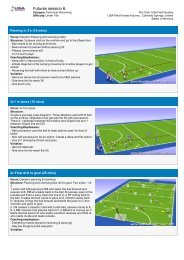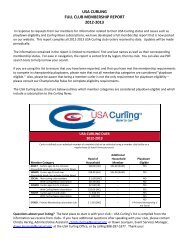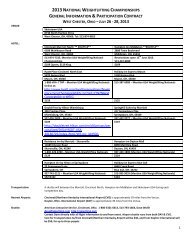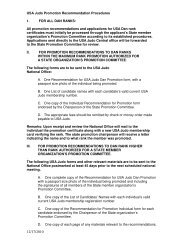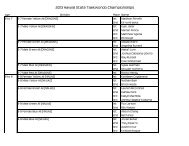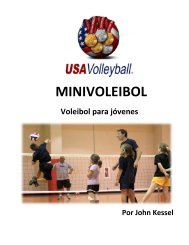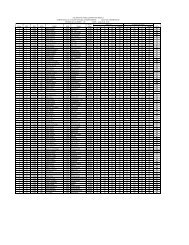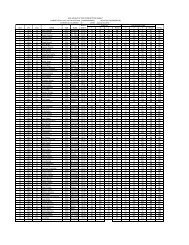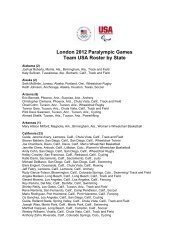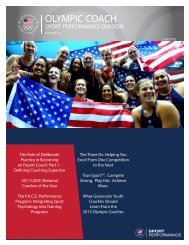Strength and Power for the Elite Swimmer 2012 - United States ...
Strength and Power for the Elite Swimmer 2012 - United States ...
Strength and Power for the Elite Swimmer 2012 - United States ...
Create successful ePaper yourself
Turn your PDF publications into a flip-book with our unique Google optimized e-Paper software.
Olympic Coach Magazine<br />
28<br />
Volume 23, Issue 2<br />
(Blair, 2011). Ideally, an elite athlete would maintain a high testosterone-cortisol ratio. A higher ratio is<br />
advantageous <strong>for</strong> many of <strong>the</strong> following reasons: preventing muscle break down, reducing body fat storage,<br />
increasing energy level <strong>and</strong> improving competitive drive (Blair, 2011). In trained individuals, it has<br />
been shown that a low volume-high intensity weightlifting program (three sets at 80 percent of six RM<br />
[repetition max]) <strong>and</strong> high volume-low intensity (three sets at 80% of 12 RM) weightlifting program both<br />
stimulated an increase in testosterone. However, <strong>the</strong> high volume-low intensity program stimulated a<br />
greater increase in cortisol levels. This leads to a lower testosterone-cortisol ratio (Leite, 2011). Thus,<br />
<strong>the</strong> use of lower volume, higher intensity strength <strong>and</strong> power weight training could be advantageous to<br />
<strong>the</strong> recovery as well as per<strong>for</strong>mance of an elite Olympic swimmer. It is important to note that naturally<br />
circulating levels of testosterone decrease with age. This important <strong>and</strong> powerful fact would suggest that<br />
it is more beneficial to an elite athlete to utilize strength <strong>and</strong> power training to help prevent decreasing<br />
levels of testosterone <strong>and</strong> maintaining <strong>the</strong> greatest testosterone-cortisol ratio possible throughout <strong>the</strong>ir<br />
athletic career.<br />
<strong>Strength</strong> <strong>and</strong> <strong>Power</strong> Reduce <strong>the</strong> Risk of Injury<br />
<strong>Strength</strong> <strong>and</strong> power training can also help to enhance per<strong>for</strong>mance by reducing <strong>the</strong> risk of injury. It is important<br />
to realize that <strong>the</strong> less frequently an elite athlete has to deal with injury, whe<strong>the</strong>r acute or chronic<br />
(tendonitis or torn rotator cuff) <strong>the</strong> more frequently an athlete can train. This increase in frequency of<br />
training may <strong>the</strong>n allow <strong>for</strong> an athlete to increase per<strong>for</strong>mance.<br />
One benefit of strength <strong>and</strong> power training is its effect on bone <strong>and</strong> connective tissue. It has been shown<br />
that resistance training, strength <strong>and</strong> power training included, has produced positive changes in bone<br />
<strong>and</strong> tissue density (Layne, 1999 <strong>and</strong> MacDougall, 1986). Increasing tissue density <strong>and</strong> tensile strength<br />
is similar to enhancing a ropes ability to deal with higher <strong>for</strong>ces. This adaptation allows <strong>the</strong> tissue to deal<br />
with larger <strong>for</strong>ces <strong>and</strong> decreases <strong>the</strong> micro-damage done by all <strong>for</strong>ces. Micro-damage to tissue is constantly<br />
occurring in any <strong>for</strong>m of training including in <strong>the</strong> pool. The stronger <strong>the</strong> tissue becomes <strong>the</strong> less<br />
micro-damage that is done to tissue within each in-pool session. With less damage, <strong>the</strong> body has less<br />
work to do to recover <strong>and</strong> thus each following training session can be more productive.<br />
Below is a microscopic photo of muscle fibers taken pre-training <strong>and</strong> post training.<br />
(Friden, et al. 1988)<br />
Pre-training Post-training



